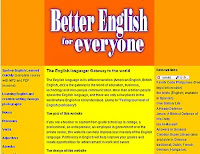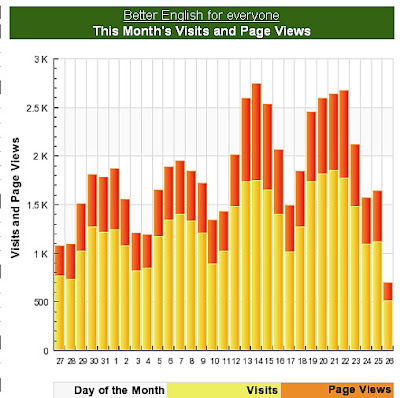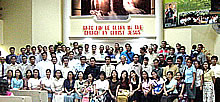 According to my Sitemeter.com tracker, my website “Better English for everyone” reached over 700,000 visitors several days ago. The website became online September 27, 2007. It has been averaging 1,500+ visitors daily this week. Google Analytics, my other website tracker, reports that visitors have come from 195 countries or territories. The top ten countries in number of visitors are the USA, Philippines, India, United Kingdom, Brazil, Thailand, Spain, Mexico, Canada, and Australia. (Jump to “How you can help this website” or “How I became involved in Internet ministries”.)
According to my Sitemeter.com tracker, my website “Better English for everyone” reached over 700,000 visitors several days ago. The website became online September 27, 2007. It has been averaging 1,500+ visitors daily this week. Google Analytics, my other website tracker, reports that visitors have come from 195 countries or territories. The top ten countries in number of visitors are the USA, Philippines, India, United Kingdom, Brazil, Thailand, Spain, Mexico, Canada, and Australia. (Jump to “How you can help this website” or “How I became involved in Internet ministries”.)
“Better English for everyone” contains numerous links to Gospel websites and my website trackers report that these have been clicked, even by visitors from Restricted Access Nations. Thanks to everyone who have browsed this site. Soli Deo gloria!
The numbers are gratifying for anyone involved in Internet ministries but they do not really represent the number of people who have actually or beneficially used this website. We have to consider factors such as bounce rates, time spent on site, number of pages viewed, etc. Due to the differences in the way these trackers work, Google Analytics reports a higher number of visitors but a lower average time spent (1:05 minutes). Oppositely, Sitemeter reports a lower number of visitors but a higher average time spent (2:55 minutes). The Sitemeter graphic above shows the number of visitors (yellow bars) and page views (red bars) from August 27 to early September 26.
The Sitemeter graphic above shows the number of visitors (yellow bars) and page views (red bars) from August 27 to early September 26.
As you can see, the number of visitors peaks on Tuesdays and Wednesdays. Saturdays have the lowest number of visitors. But from my analysis of the detailed statistics (not shown in the graphic above), visitors during Saturdays and Sundays usually views more pages and spends more time on the website than visitors during Tuesdays and Wednesdays.
Based on the keywords they used in searching Google (“lesson plan”, “worksheet”, “printable”, etc.), the visitors are typically ESL or EFL teachers.
Google Analytics report on top ten countries from August 24 to September 24, 2011 (click the graphic to see the clear, enlarged view) 30% of users spend 60 seconds or more per visit
30% of users spend 60 seconds or more per visit
This time factor (derived from Sitemeter reports) is significant based on Jakob Nielsen’s article “How Long Do Users Stay on Web Pages?”. Nielsen, citing a massive study by Microsoft Research, says:
The first 10 seconds of the page visit are critical for users’ decision to stay or leave. The probability of leaving is very high during these first few seconds because users are extremely skeptical, having suffered countless poorly designed Web pages in the past. People know that most Web pages are useless, and they behave accordingly to avoid wasting more time than absolutely necessary on bad pages.The average time spent by visitors to “Better English for everyone” is 1:05 minutes (Google Analytics) or 2:55 minutes (Sitemeter). In his article, Nielsen says that “the average is not the most fruitful way of analyzing user behaviors”. Based on my analysis of Sitemeter reports, 30% of users spend 60 seconds or more per visit. This pattern has been consistent since early last year.
If the Web page survives this first — extremely harsh — 10-second judgment, users will look around a bit. However, they’re still highly likely to leave during the subsequent 20 seconds of their visit. Only after people have stayed on a page for about 30 seconds does the curve become relatively flat. People continue to leave every second, but at a much slower rate than during the first 30 seconds.
So, if you can convince users to stay on your page for half a minute, there’s a fair chance that they’ll stay much longer — often 2 minutes or more, which is an eternity on the Web.
How you can help “Better English for everyone”
[1] If your church or ministry would like to sponsor the web hosting fees for “Better English for everyone”, please email me at gtgalacio@yahoo.com for more information. My current web hosting plan with dot.PH Domains is US $66 per quarter with a monthly bandwidth limit of 15 GB. The bandwidth limit for September will be reached early next week. Once the limit is reached, the website will be offline (until it refreshes for the next month within the quarter). The quarter ends on October 8, 2011.
Because of the increasing number of visitors, I need to upgrade to the next higher plan of US $155.40 quarterly billing (US $41.80 monthly) with a bandwidth limit of 30 GB per month. With annual billing, the cost is lower at US $38 monthly or a total of US $458.00.
[2] More than 90% of visitors reached “Better English for everyone” through search engines like Google and Yahoo. You can help increase traffic to this website by posting links to it from your websites, blogs, Facebook, Twitter, and other social media.
Internet ministries
My Internet ministries consist of two websites www.familymatters.org.ph and www.betterenglish.org.ph, and several blogs, namely, “Salt and Light” (articles on relationships, marriage, family), “Baptist Churches in the Philippines” (directory of churches); “Legal Updates”, “Campus Connection”(youth-oriented articles including photography), “A picture is worth a thousand words”, and “Baptist Distinctives, free online Bible Institute for Asia, Africa and Latin America”. I also have free PDF newsletters available for download on legal issues affecting the Filipino family.
If you want to know more about web ministries, please surf to the Internet Evangelism Day website.
How I became involved in Internet ministries
I have always been interested in reading and writing. During my grade school days in the 1960’s, I woke up early everyday to go to the guardhouse and read all the English newspapers delivered to a Chinese business tycoon who owned the compound I grew up in. Afternoons after my classes, I would again go to the guardhouse to read the Evening Post (if I remember the newspaper’s title correctly).
That Chinese business tycoon had in his garage a room filled, from floor to ceiling, with hundreds of Reader’s Digest, Life Magazine, Saturday Evening Post, and other magazines. During school breaks, I would spend hours there reading. Whenever I missed lunch, my mother would begin looking for me and she would always find me in that room.
During my high school years (Rizal High School, 1969-1973), I continued my habit of reading newspapers; I spent part of my lunch breaks in the library. In my junior year, I became a sports reporter for our schoolpaper “The Rizalian”. The adviser, Miss Consolacion Constantino, patiently edited my articles, but none of my articles was ever published.
After I lost my NSDB mining engineering scholarship in UP Diliman, I followed the UP guidance counselor’s advice that I should go into writing as a college course and career. I graduated in 1979 with an AB English degree from Philippine Christian University.
I became an English grammar teacher (Dona Aurora High School in San Mateo, 1981-1983), and then a journalism teacher and schoolpaper adviser (Quezon City Science High School, 1983-84, and Rizal High School, 1984-1995). In 1985, I enrolled in a BASIC programming course in my alma mater PCU. In my work, I learned desktop publishing (Pagemaker 4), word processing (MS Word 2), and graphics (Coreldraw 3), using our school’s 486 computer, Brother laser printer, and flatbed scanner. (My first computers were a Texas Instrument 99/4A with 16k of memory and a Commodore 64, both gifts from my nephew Ken.)
I was admitted into the Philippine bar in 1995 and practiced law until 2005 when I stopped accepting cases.
In 2003, as I was surveying the ministries still open to me considering my age and circumstances, I learned that online writing was a viable ministry. I canvassed several schools and institutions where I could possibly learn website design. One company in Shaw Boulevard (opposite Jovan Condominium) charged Php 60,000 for its website design course. Too expensive. Genetics Computer Institute had a website design program costing Php 16,000 while Informatics offered its program at Php 20,000. Their curriculum was not what I really needed. Meralco Foundation offered an HTML course at only Php 4,000 but by that time, I had already learned how tedious and error-prone hand coding was.
I began buying books on website design; the books were very expensive, with prices ranging from Php 500 to Php 1,700 (Vincent Flanders’ Son of web pages that suck). I read through the books even though I could not really understand what I was reading. I then bought from a computer bookstore in SM Megamall and SM Centerpoint several tutorial CDs on Dreamweaver and Microsoft Frontpage.
In 2005, I designed and printed out using Pagemaker 5 a sample page of what I wanted my website to look like. To inspire and challenge myself, I brought the printout wherever I went and looked at it from time to time; I also showed it to friends, telling them that I was designing a website. Applying what I learned from designing yearbooks in my work as a schoolpaper adviser, I did a detailed storyboard for each page of my website. Starting that January, I spent my mornings reading my Dreamweaver book and studying the tutorial CD. I thought that I did not have to understand or learn everything about website design. I only had to learn whatever I needed for the website as I conceptualized it. All this time, I also began learning what blogs were.
By late October 2005, I already had created my first blog (“Legal Updates”). I finished designing my website www.familymatters.org.ph by late November. Although I had registered the domain name and paid the web hosting fees by early December, I did not know how to upload the files from my computer to the server. I did not know what FTP (file transfer protocol) was.









